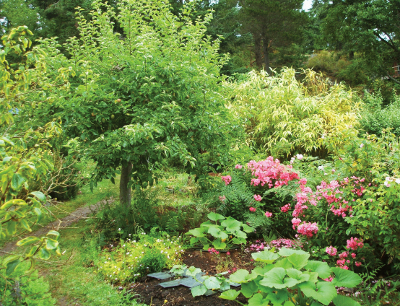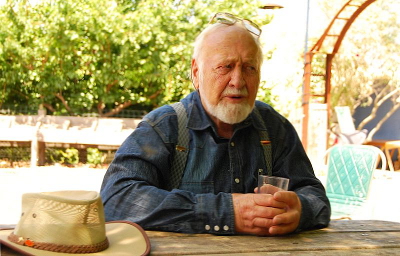
Mollison and Hemenway on forest gardening
 The theme of Will
Hooker's lecture
5 is biomes and trees, and even though I have a poster of the
former on my bedroom wall and adore the latter, the lecture bored
me stiff. If you're going to skip one lecture, it should be
this one. Hooker's take-home message, though, is very valid
--- if you're not settled in one spot yet, be sure to learn about
the ecosystem you move into and tweak your permaculture plans
accordingly.
The theme of Will
Hooker's lecture
5 is biomes and trees, and even though I have a poster of the
former on my bedroom wall and adore the latter, the lecture bored
me stiff. If you're going to skip one lecture, it should be
this one. Hooker's take-home message, though, is very valid
--- if you're not settled in one spot yet, be sure to learn about
the ecosystem you move into and tweak your permaculture plans
accordingly.
On the other hand,
the associated readings were riveting, so that's what I'll write
about today. As you'll recall, both Toby Hemenway and Bill
Mollison included a chapter on forest gardening in their
introductory texts, and it's fascinating to compare and contrast
their recommendations.
Both gurus recommend
interplanting trees, shrubs, and herbs, but Mollison focuses in on
including lots of legumes
to make your forest self-fertilizing, and he also writes about using animals
in your orchards.
"Should you be so unfortunate as to inherit a monocultural
orchard," he wrote, "add 3-4 hens, a pig, and 4-6 large leguminous
trees per 1000 square meters (1/4 acre), with many smaller
legumes." Mollison went on to recommend introducing pigs to
your orchard when the trees are three-to-seven years old, then
sheep and cattle at seven-to-twenty years.
 Although both
authors wrote about cover crops and
kill
mulches, I preferred Hemenway's suggestions to kill mulch
zones 1 and 2, then use low-maintenance cover crops in zone 3.
(Specifically, Hemenway prefers a mixture of clover, annual rye,
yarrow, dill, fennel, and daikon radishes that only needs to be
mown once or twice a year.) Mollison adds that your orchard
for personal use should be considered zone 2, while any commercial
operation extends out into zone 3.
Although both
authors wrote about cover crops and
kill
mulches, I preferred Hemenway's suggestions to kill mulch
zones 1 and 2, then use low-maintenance cover crops in zone 3.
(Specifically, Hemenway prefers a mixture of clover, annual rye,
yarrow, dill, fennel, and daikon radishes that only needs to be
mown once or twice a year.) Mollison adds that your orchard
for personal use should be considered zone 2, while any commercial
operation extends out into zone 3.
My main
disappointment with both explanations of forest gardens is their
recommendation to include prolific understory herbs. In
fact, Mollison writes that broadleaf plants are much better around
the feet of young trees than grass is, but my own experience has
shown that anything interfering with the
root zone of young trees slows growth markedly when compared to a solid
mulch. Of course, my original soil is terrible, so those of
you with deep, well-drained loam might have better luck applying
these guru's wisdom without tweaking.
Want more in-depth information? Browse through our books.
Or explore more posts by date or by subject.
About us: Anna Hess and Mark Hamilton spent over a decade living self-sufficiently in the mountains of Virginia before moving north to start over from scratch in the foothills of Ohio. They've experimented with permaculture, no-till gardening, trailersteading, home-based microbusinesses and much more, writing about their adventures in both blogs and books.
Want to be notified when new comments are posted on this page? Click on the RSS button after you add a comment to subscribe to the comment feed, or simply check the box beside "email replies to me" while writing your comment.
